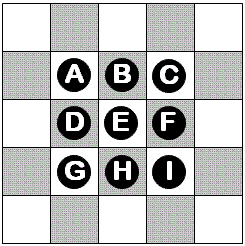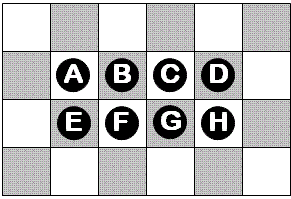|
Henry Ernest Dudeney and Sam Loyd both had variations of this puzzle. A small (5x5) checkerboard is arranged with nine pieces as shown. The pieces (shown as lettered circles) act like 'kings' in checkers except that they can move in all eight directions (up, down, right, left, and diagonally). They can step into an adjacent square or jump over another piece (removing the jumped piece from the board). For example, B could jump A, C, D, or F, or B could step into any of the three middle squares on the top row. As in checkers, a piece can continue jumping as long as the opportunity remains. Unlike checkers, a piece isn't required to jump if the opportunity exists.

Challenge 1: In the smallest number of moves, end with only one piece left on the board – in the center of the board. A move consists of a step to an empty adjacent square or a series of jumps by the same piece.
The answer section shows three different solutions. One uses only jumping moves; the other two use two jumping moves (and some stepping moves).
Challenge 2: Here is a variation of my own. Now consider a different board with eight checkers. What is the fewest number of moves needed to remove all but one piece?

|

